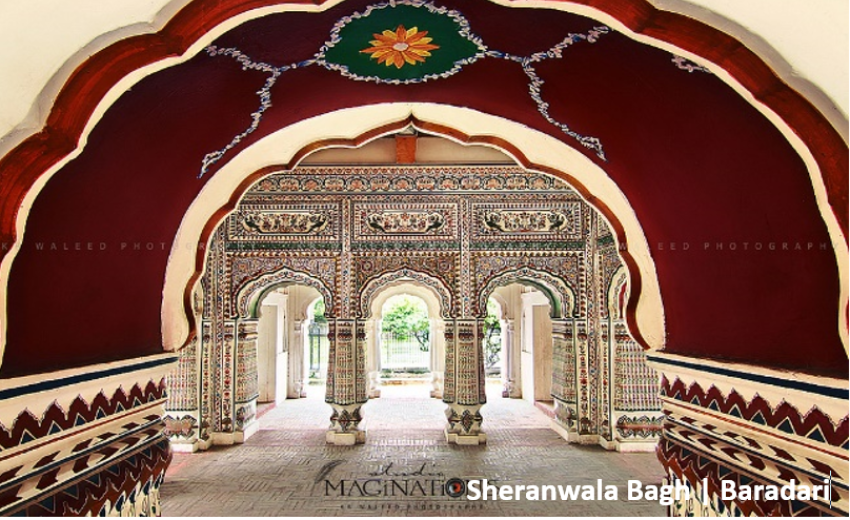Somebody preserve it, please
This is the Samadhi of Sardar Charat Singh, which is behind Sheranwala Bagh (the Garden of Lions) on GT road, inside Gujranwala city
Gujranwala is a comparatively a new city but settlements existed in this area since long. The foundations of the modern city were laid down in 1758, when Charat Singh constructed a small mud fort at Sirai Kambohaan. With the initial Sikh settlements in Gujranwala, there grew the trend of construction of Gurdwaras and Havelis. The Havelis of Maharaja Ranjit Singh as well as his ancestors are still found in this city, but not really well maintained. This city can be one of the biggest hubs in terms of religious tourism if the government wishes to develop it for this purpose.
Here I am writing about a controversial place which in some references is known as a Gurdwara and in some a Jain Mandir. This is the Samadhi of Sardar Charat Singh, which is behind Sheranwala Bagh (the Garden of Lions) on GT road, inside Gujranwala city. Presently there are few houses inside it. There used to be a Baradari (summer house with 12 entrances) built by Maharaja Ranjit Singh which has vanished now.
Sardar Charat Singh was sardar of Sukerchakia Misl. Charat Singh (died 1774) was the eldest son of Naudh Singh, the father of Mahan Singh, and the grandfather of Ranjit Singh. He distinguished himself at an early age in campaigns against Ahmad Shah Abdali and along with 150 horsemen split from the Singhpuria Misl to establish the Sukerchakia Misl.
The 18th century was a period of turmoil in Punjab when the Afghans devastated the whole region from Indus to Jamna and the Mughal Empire was also breathing its last by the 1750s. The active Sikhs made use of this chaos and in the 1760s quickly emerged as the strongest force in Punjab and the central Punjab fell into their control. It is said that Lahore was captured by Sikhs on 16 May 1764. Then, except for a few months in 1767 and later for a few days in 1797, it remained in control of Bhangi Misl. Misls were twelve independently operating Sikh groups, under different warlords, active in different regions of Punjab. One of them was Sukherchakia Misl, based at Gujranwala and controlling surrounding areas, and constantly at war with neighbouring Muslim chiefs like Chatthas, etc, and also with other Sikh or Hindu chiefs. In these circumstances Ranjit Singh was born on 13 November 1780 and at the death of his father Mahan Singh in April 1790, he became the sardar of his Misl. His rise was quick and by 1799 he occupied Lahore and by 1809 wrested the control of all the areas west of Sutlej from other Sikh Misls. By a treaty in the same year River Sutlej was agreed upon as the border between British India and his state. So he changed his focus to other directions and by the time he died in 1839, the whole of present day Pakistani Punjab (except Bahawalpur), most of KP and Kashmir was conquered by him. Sikhs rightly take great pride in the rise of Ranjit Singh, being the greatest ruler they ever produced. He is often called Sher-e-Punjab or the Lion of Punjab.
Despite the controversy over this site it should be restored and opened for tourists. In my opinion a thorough research should be carried out by the archeologists to dig out the history of this place
I found the Samadhi of Charat Singh there in Gujranwala but it is not a well known place and few people know about it. At present a police station has been established in its premises, known as Thana Sabzi Mandi. There, behind the main gate, stands the majestic building of the Samadhi in a huge courtyard. The building is no doubt in shambles and needs some preservation. I wonder why it escaped from the eyes of the Archeology Department of Punjab. This site can be established as a hot tourist spot. I am sure Sikhs themselves will be happy to contribute in this regard.
Now here comes the controversy related to this Samadhi. It is said by historians that this is actually a Jain Mandir. The references of this Mandir are given in different books on Jain religion. The books tell that the building is a Jain Mandir built in memory of a great Jain scholar Shri Atmaramji.
Acharya Vijayanand Suri (1837–1896), also known as Atmaramji of Gujranwala, was the first Swetambar Murtipujaka Jain monk in modern times to receive the title of Acharya. He was given the title of Navyug Nirmata (builder of a new era) by his disciple Vallabhsuri. Shri Atmaramji’s father was an army official of Ranjit Singh. He was initiated at the age of sixteen and was given the name of Atmaramji. Atmaram began the study of Jain scriptures along with his fellow ascetics. He died in Gujranwala (now in Pakistan) on 20 May 1896. A memorial shrine dedicated to him was built there. Some historians, rather many, claim that this place is the Jain Mandir of Atmaramji and not the Samadhi of Charat Singh.
Despite the controversy over this site it should be restored and opened for tourists. In my opinion a thorough research should be carried out by the archeologists to dig out the history of this place. There are a lot of such places in Pakistan which are debatable and unobvious in terms of whom they belonged to. For example the tomb of Zeb un Nisa in Lahore is also contentious. In our country we lack the research and interest in such topics, where as if we observe the other countries they work hard to dig out their history. Moreover, I would request the department of archeology to please look into the sites located in Gujranwala and make it a place known for religious tourism. Also the Sikh communities can be contacted and maybe they are able to help in the history and also the maintenance of these places. These locations should also be declared protected monuments and the misuse should be stopped. I hope one day this trend changes and our people develop a mindset for promoting tourism. Samadh Sardar Charat Singh, Gujranwala The Samadh of Sardar Charat Singh, is behind Sheranwala Bagh on G.T. road, inside Gujranwala city. It appears to be the gate on a mansion. Presently there are few houses inside it. There used to be a Baradari (Summer house with 12 entrances) built by Maharaja Ranjit Singh which has vanished now. Sardar Charrat Singh was the founder of Sukkerchakia Misl and grandfather of Maharaja Ranjit Singh. He was born in Samvat 1779 and fought a life long battle for the establishment of Khalsa Raj. He captured Gujranwala and succeeded in establishing a Sikh principality over a large area. He died in Samvat 1832 (1722 AD) when his matchlock accidently exploded. The building of Samadh is strong and beautifully built.

